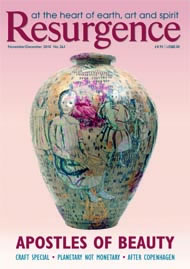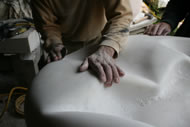Quilts have had a good year. The popularity of the recent V&A Museum exhibition showed that there is enormous appetite for the product and process of craft, and deservedly so. Visitors could not have failed to be moved by the beauty of the artefacts and the skill of the makers, many of whom remain poignantly anonymous, their names lost in time. To appreciate the work of a craftsperson, one needs to step back and recalibrate an understanding of what it means to work with the hands, an exercise brilliantly articulated by Richard Sennett in his book The Craftsman. But, scholarly analysis aside, there is also much to be learnt through participation in the act of making. Quite apart from the enjoyment of the finished product, the process of working with the hands allows us to tap into wisdom that transcends the constraints of time, place or language.
My own re-engagement with craft came a few years ago during an extended period of illness. I lacked the concentration to read, but felt the need to occupy myself during the long hours at home and – as one so often does in testing times – gained comfort from returning to skills I had made infrequent use of since childhood. Since I had a suitcase full of old pieces of fabric, a patchwork quilt seemed like a good project. What I did not appreciate when I started was just how much I would learn – and not only in terms of practical skills.
Making and learning through touch and manipulation of materials has an important role in early years education, but it becomes devalued as literacy develops. Although initially regarded as fine instruments for learning, the hands are effectively downgraded as mere devices for holding pens or tapping keyboards. By implication, therefore, craft becomes a kind of indicator of a lack of literacy: at worst, it is seen as being for those who never really got to grips with the written word. But it is this popular misrepresentation of making by hand that I wish to challenge.
Craft is inevitably a sensory experience. For me, there is much pleasure to be taken from handling fabrics, juxtaposing patterns and colours, creating a personalised visual display. No doubt this is true of other crafts: a wood-turner appreciates and has an empathy with the material with which he or she works, as does a potter at the wheel. In the face of a culture that increasingly emphasises image over material substance, re-engagement with the raw materials from which our lives are shaped is a potent reminder of the difference between what is real and what is illusory in life.
Through making that patchwork quilt, I learnt that repetitive actions, once mastered, need not be laborious. Rather, they occupy the body in such a way as to permit the mind to wander. While one is exercising non-verbal parts of the brain, thoughts start to flow in different patterns, producing solutions to nagging problems or ideas for new ventures. The rhythm of repetitive handwork is a different beat to work to – hardly surprising, then, that singing has a long tradition of accompanying repetitive work. And with that repetition comes the acquisition of skill: one learns the shortcuts and the importance of sequential action, about when to keep going and when to stop.
A handcrafted object also raises the philosophical question of how to deal with imperfection. Industrial processes have all but eliminated the very concept: we rarely accept ‘seconds’ in the world of mass-produced consumer goods. But anyone who has ever made anything by hand will know the dilemma involved in dealing with a ‘mistake’. On some occasions, it will be undone and reworked, with a rueful ‘note to self’ about taking more care next time. On other occasions, the mistake will just become part of the finished object, an acknowledgement that human hands are not machines. On a more abstract level, it is useful to distinguish the difference between fatal flaws and those that can be lived with. To accept imperfection in one’s work is a step towards accepting imperfection in oneself.
On a more practical level, craft provides the maker with an opportunity to be uniquely eco-conscious. In particular, patchwork is a beautiful way to use up leftovers and cast-offs. I literally pieced together fabrics from different periods of my life: little visual reminders of clothes I had worn and places I had been. Charity-shop finds sit alongside scraps from favourite shirts, and every piece has a place. For me, the ingenuity of the craftsperson is something to marvel at: it underlines the ethos of making considered use of the material world rather than tearing through it with no thought given to its fragile nature and finite limits.
Makers are devalued in contemporary society. There is an unvoiced assumption that those who use their hands have failed to master intellectual hurdles of school, exams, university, professional training, and so on. For a few lucky individuals, ‘craft’ is elevated to ‘art’ and they are permitted membership of a privileged cultural elite, but for the most part we associate manual work with deprivation, poverty and workforce exploitation. My point here is not to suggest that the pleasure of making something in the comfort of one’s own home bears any resemblance to grinding sweatshop labour. Rather, it is a reminder that such a job deserves a fair wage, and may even make us think twice about buying cheap mass-produced goods.
Unless one is very fortunate in terms of career openings, the structures of contemporary life provide limited opportunities for pride to be taken in work. In some small way, to make something is to understand and appreciate the value of work – itself a denigrated term, usually prized only for its exchange value in monetary terms. But anyone can utilise the work of their own hands in their everyday life. Conceptually, making need not be restricted to such obvious examples as sewing a quilt or making a piece of furniture. Cooking, making music, gardening – any of these activities can and should be recognised as craft.
Nor should making be the sole preserve of those who consider themselves to be ‘creative’ by trade. One of the most prolific quilters I know is a lawyer who works long hours and has limited free time. Yet she has made quilts for the babies of numerous friends and family members in the past year or so, each quilt unique, each made with much love.
Finishing a project is sometimes the hardest part, and when I came to the end of my quilt, I feared that it might become an unwelcome reminder of those long weeks of illness. Happily, though, its completion kick-started other creative endeavours and it has become a comforting reminder of how the hands can be used productively to shape our material world and the objects we surround ourselves with.








